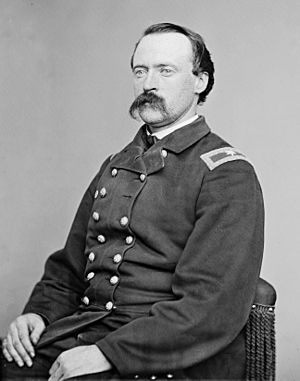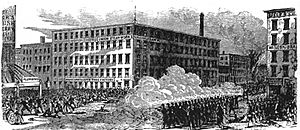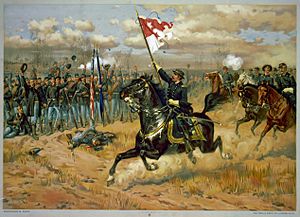Oliver Edwards facts for kids
Quick facts for kids
Oliver Edwards
|
|
|---|---|
 |
|
| Born | January 30, 1835 Springfield, Massachusetts |
| Died | April 28, 1904 (aged 69) Warsaw, Illinois |
| Buried |
Oakland Cemetery, Warsaw, Illinois
|
| Allegiance | United States of America |
| Service/ |
United States Army Union Army |
| Years of service | 1861–1866 |
| Rank | |
| Commands held |
|
| Battles/wars | American Civil War |
| Other work | Superintendent, Florence Machine Company General Manager, Gardner Machine and Gun Company |
Oliver Edwards (born January 30, 1835 – died April 28, 1904) was a talented inventor and a brave officer in the Union Army during the American Civil War. He also had a successful career managing factories.
Edwards grew up in Springfield, Massachusetts. When he was young, he moved to Illinois to work in manufacturing. When the Civil War started, he joined the army. He became an assistant to a general and later led the 37th Regiment Massachusetts Volunteer Infantry. He led his soldiers through many important battles, including the Battle of Gettysburg. After the war, Edwards went back to working in factories. He became a manager at the Florence Machine Company and the Gardner Machine and Gun Company.
Contents
Early Life and Career
Edwards was born in Springfield, Massachusetts, in 1835. His parents were Dr. Elisha Edwards and Eunice Lombard Edwards. From a young age, Oliver was very interested in how machines worked. Instead of going to college, he learned by working at the Springfield Armory. This was a place where weapons were made.
In 1856, when he was 21, Edwards moved to the Midwest. He wanted to start his own metal factory. He settled in Warsaw, Illinois, and became a partner in a new factory called Neberling, Edwards and Co.
Service in the Civil War
Joining the Army
When the Civil War began in 1861, Edwards went back to Massachusetts. He wanted to join the army as a regular soldier. In May and June 1861, he gathered a group of men from Springfield. This group became part of the 10th Massachusetts Infantry.
When the 10th Massachusetts was officially formed, Edwards was offered a special job. He became a first lieutenant and the "adjutant." An adjutant is like an administrative assistant to the commander of a regiment. Edwards helped Colonel Henry Shaw Briggs manage the soldiers.
Edwards did not see much fighting at first. His regiment spent the end of 1861 building forts near Washington, D.C.. In January 1862, General Darius N. Couch asked Edwards to be his "aide-de-camp." This meant Edwards would be a personal assistant to the general. He helped General Couch plan and coordinate his division's movements during the Peninsular Campaign and the Northern Virginia Campaign.
Leading the 37th Massachusetts
On August 9, 1862, Edwards was promoted to major. He was sent to Pittsfield, Massachusetts, to help organize a new group of soldiers, the 37th Massachusetts Infantry. Soon after, he was promoted again to colonel and given command of the entire 37th Massachusetts regiment. The regiment arrived in Washington, D.C., in September 1862. They joined the Army of the Potomac and became part of the VI Corps.
Edwards had been in battles before, but his first time leading soldiers in combat was at the Battle of Fredericksburg on December 13, 1862. His regiment was kept in reserve, so they did not play a big part in the fight.
During the Chancellorsville Campaign in May 1863, Edwards and the 37th Massachusetts fought in the Second Battle of Fredericksburg and the Battle of Salem Church. In the Battle of Salem Church, the 37th was in a very dangerous spot. After the battle, Major General John Sedgwick praised the 37th for holding their ground.
The 37th Massachusetts also fought at the Battle of Gettysburg in July 1863. On the third day, they were moving to a new position when the Confederates started a huge cannon attack. Most Union regiments took cover, but the 37th had to keep marching. They lost many soldiers. However, Edwards was praised for keeping his regiment together and brave during this dangerous march.
Helping in New York
On July 30, 1863, the 37th Massachusetts was chosen to go to New York. This was after the New York Draft Riots, where people protested against being forced to join the army. By the time Edwards's regiment arrived, the worst of the riots were over. But a strong army presence was needed to keep the peace.
Edwards commanded a group of soldiers stationed at Fort Hamilton in Brooklyn. He heard that having soldiers from Massachusetts might make the rioters angry again. So, he asked to place his regiment as guards at a draft office. He wanted to show how brave his men were. Despite the worries, Edwards's regiment did not cause any more trouble.
Leading a Brigade
In October 1863, Colonel Edwards and the 37th Massachusetts returned to the Army of the Potomac. They took part in the Mine Run Campaign and then settled into winter camp. In the spring of 1864, the 37th was involved in the Overland Campaign. This was a series of intense battles where Lieutenant General Ulysses S. Grant tried to defeat the Confederate army and capture Richmond.
During the Battle of the Wilderness on May 6, 1864, Edwards was ordered to lead the 37th Massachusetts on a risky charge. They had to stop a Confederate advance and protect a retreating Union division. Edwards led his men forward, but they became surrounded. The regiment retreated in an organized way, firing constantly under Edwards's command. However, they lost 25 percent of their soldiers in this fight.
After fighting in the Battle of Spotsylvania, Edwards was promoted to command a "brigade." A brigade is a larger group of soldiers than a regiment. He led the 4th Brigade, 2nd Division of the VI Corps, through the rest of the Overland Campaign, including battles like Battle of North Anna and Battle of Cold Harbor.
In July 1864, Edwards's brigade was reorganized. Three divisions of the VI Corps were sent to Major General Philip Sheridan in the Shenandoah Valley. They fought in the Valley Campaigns during the summer and fall of 1864.
A key moment for the Union Army in this campaign was the Battle of Opequon at Winchester, Virginia, on September 19, 1864. During this battle, Edwards was temporarily put in charge of the 1st Division of the VI Corps. He did so well that Major General Sheridan noticed him. Sheridan then made Edwards the commander of Winchester.
On December 12, 1864, President Abraham Lincoln nominated Edwards for an honorary rank of "brevet" brigadier general. A brevet rank is an honorary promotion for bravery, but it doesn't always come with more pay or command. This was for his bravery at the Battle of Spotsylvania and the Battle of Opequon. The U.S. Senate approved this award on February 14, 1865.
Edwards and his brigade returned to the Army of the Potomac during the long Siege of Petersburg. On April 2, 1865, during the Third Battle of Petersburg, Edwards's brigade was the first Union group to break through the Confederate defenses outside Petersburg. After the Confederates left their forts, Edwards personally accepted the surrender of the city from the mayor of Petersburg.
On May 19, 1865, President Andrew Johnson nominated Edwards for the full rank of brigadier general. Even though Edwards left the army on January 15, 1866, the Senate confirmed his promotion on February 23, 1866. On July 9, 1866, President Johnson also nominated Edwards for the honorary rank of brevet major general. This was for capturing Confederate Lieutenant General Richard S. Ewell and an entire brigade of Confederate soldiers at the Battle of Sayler's Creek during the Appomattox Campaign. The U.S. Senate confirmed this award on July 23, 1866.
After the war ended, Edwards continued to serve in the army for the rest of 1865. He was offered a permanent job in the regular army, but he decided not to take it. He resigned his commission on January 15, 1866.
Life After the War
After the war, Edwards returned to Warsaw, Illinois. He reunited with his wife, Ann Eliza Johnston Edwards, whom he had married in September 1863 while on leave from the army. They had two children, John E. Edwards and Julia Katherine Edwards.
Edwards worked as the postmaster in Warsaw for three years. Then he moved back to Massachusetts to continue his career in manufacturing.
In 1870, Edwards was hired by the Florence Machine Company in Northampton, Massachusetts. He eventually became the general superintendent, which means he was in charge of the factory. During this time, Edwards invented several things, including the Florence ice skate and the Florence oil stove.
He left the Florence Machine Company in 1875 and went back to Warsaw, planning to retire early. However, his plans changed in 1882 when he was offered a job as general manager of the Gardner Machine and Gun Company in England. This company made Gardner guns, which were invented in the United States but bought by the British Army. Edwards managed the company for a few years, but his health got worse. He had to resign and return to Warsaw to retire for good.
He spent his last years enjoying his hobbies and supporting groups like the Grand Army of the Republic. Oliver Edwards died in Warsaw on April 28, 1904.
Images for kids






